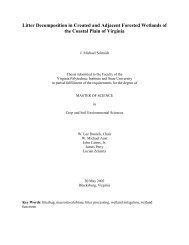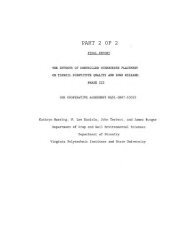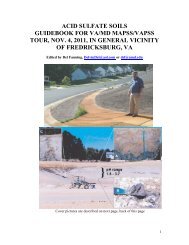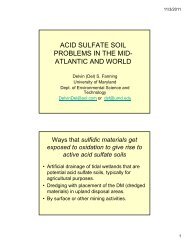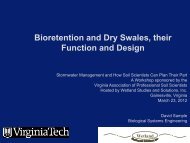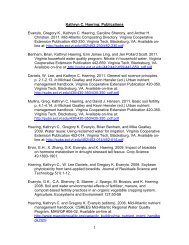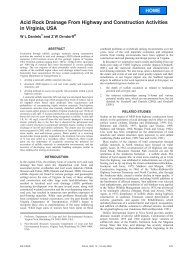Remediation of PAH-Contaminated Soils and Sediments: A ...
Remediation of PAH-Contaminated Soils and Sediments: A ...
Remediation of PAH-Contaminated Soils and Sediments: A ...
You also want an ePaper? Increase the reach of your titles
YUMPU automatically turns print PDFs into web optimized ePapers that Google loves.
Abstract<br />
Polycyclic aromatic hydrocarbons (<strong>PAH</strong>s) are the product <strong>of</strong> incomplete<br />
combustion, i.e. the burning <strong>of</strong> fossil fuels, forest fires, coal tar, creosote, diesel<br />
<strong>and</strong> cigarette smoke. These organic chemicals are found almost everywhere<br />
<strong>and</strong> pose a risk for human health because <strong>of</strong> their potentially carcinogenic nature<br />
<strong>and</strong> bioavailability in water, soil, sediment, <strong>and</strong> air resources that humans come<br />
in contact with daily. Because <strong>PAH</strong>s are emitted naturally through forest fires<br />
<strong>and</strong> volcanoes, microorganisms have the ability to breakdown <strong>PAH</strong>s <strong>and</strong><br />
contaminated sites can be remediated through microbial <strong>and</strong> environmental<br />
manipulations. Previous research on remediation <strong>of</strong> <strong>PAH</strong> contaminated<br />
resources have been conducted in situ (superfund <strong>and</strong> industrial sites), ex situ in<br />
bioreactors, or in a lab setting with soils spiked with various levels <strong>of</strong> <strong>PAH</strong>s. Very<br />
few studies have focused on the risk or cleanup techniques involved with the<br />
transport <strong>and</strong> remediation <strong>of</strong> <strong>PAH</strong> contaminated materials, such as dredge<br />
sediments.<br />
The focus <strong>of</strong> this literature review is the degradation <strong>of</strong> <strong>PAH</strong>s in dredge<br />
sediments placed in an upl<strong>and</strong> setting, where anaerobic conditions exist during<br />
initial dewatering <strong>and</strong> shift to aerobic conditions during soil formation. Dredging<br />
operations involve the removal <strong>of</strong> underwater sediments to maintain ports <strong>and</strong><br />
waterways around the United States. Finding beneficial uses for the dredged<br />
sediment, such as beach nourishment, dewatering for topsoil material,<br />
aggregate, <strong>and</strong> fill, is an important component to these operations from an<br />
environmental <strong>and</strong> economic viewpoint. Previously, clean dredged sediment<br />
(without salts or organics) has successfully been placed in upl<strong>and</strong> confinements<br />
for dewatering <strong>and</strong> future use as agricultural soil. However, there is a limited<br />
amount <strong>of</strong> clean dredge material, so there is a growing interest in accepting <strong>and</strong><br />
remediating contaminated dredge sediments from rivers <strong>and</strong> ports that have<br />
been impacted with industrial byproducts <strong>and</strong> contain varying levels <strong>of</strong> <strong>PAH</strong>s.<br />
This literature review provides information on:<br />
� <strong>PAH</strong> chemistry<br />
� behavior <strong>and</strong> <strong>PAH</strong> concentration ranges in different environments<br />
� <strong>PAH</strong> bioavailability<br />
� transfer, degradation <strong>and</strong> sequestration <strong>of</strong> <strong>PAH</strong>s in sediments <strong>and</strong> soils<br />
� biological techniques for enhancing <strong>PAH</strong> degradation<br />
� chemical techniques for enhancing <strong>PAH</strong> degradation<br />
� regulations pertaining to dredge material contaminated with <strong>PAH</strong>s<br />
� sampling <strong>and</strong> analytical methods<br />
3



